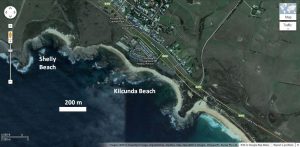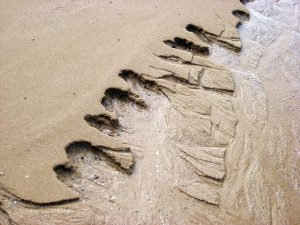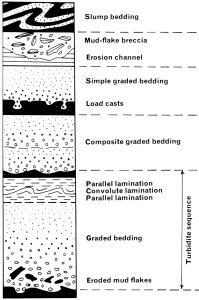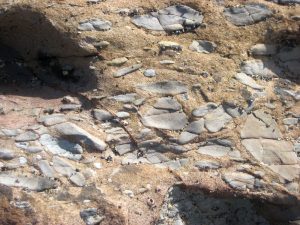
Drive off Phillip Island across the road bridge through San Remo to the Bass Highway. Turn right at the roundabout and after about 5 kilometres you will reach Kilcunda where there is ample parking on the right at Kilcunda Foreshore Reserve. You can access the beach via wooden stairs. (You could also visit Shelley Beach, turning off just 400 metres along the highway before you reach Kilcunda, along a short, unsealed road.)
Kilcunda Beach is a lovely beach but remember that the rocks can be slippery and the waves treacherous so be very conscious of your safety. It looks a nice beach for the family.
There is a large sandstone rock platform at this beach with rock pools and other interesting features. Note from your geological map that the sandstone in this area is called the Strzelecki Group and is classified as Cretaceous. From your geological map you can see that this same rock unit outcrops around San Remo.

Note the sand on the beach, its composition, size, and shape of the grains. Where did it come from? How far has it been transported and for how long? Check the beach sand for ripple marks and animal footprints. Check also the patterns of erosion produced in the sand by seepage and small streams and imagine these patterns were hundreds of times larger—the size of mountain ranges and valleys.
Check the rocky outcrops on the beach and the rock headlands. Note the similarities and differences between these rocks and those on Phillip Island.

There may be some minerals deposited into the sandstone. Notice the iron staining and how the iron-rich areas stand up higher than the surrounding sandstone because they are harder to erode. Notice the pattern of jointing in the sandstone, how sets of joints tend to run parallel to each other and cut across other sets of joints cutting the surface into rectangles like a pavement. Notice how the sandstone has been eroded in places forming interesting patterns.

What is cementing the grains of sand together to form the hard rock? Often it is silica (quartz—which cannot be scratched with a knife), an iron mineral (which looks brown or red), or calcite (which can be scratched with a knife or key). Where did this cement come from? The special conditions of the global Flood can explain the origin of the vast quantities of cementing minerals that were deposited in the pore spaces (gaps) within the sandstone.Look to see if the beds are folded or tilted. If tilted, what direction do the beds slope toward and at what angle?
Significance
This site can give some idea of the size and extent of the sandstone deposits that form the Strzelecki Group. The thickness of the strata points to deposition from fast flowing water, which is consistent with Flood deposition. The flatness of the layers suggests the fast flowing water covered a large area. There are many indications of fast flowing water and rapid sedimentation, which is consistent with the Flood, such as pebble horizons and rip-up mud flakes. The rocks also include mud layers and these have generally been interpreted as being deposited in still water. However, recent research has found that mud readily deposits from flowing water. The thickness of the deposit indicates that the water was continually deepening to allow the thick accumulation of sediment.
Guide available as a booklet
This entry is taken from the geological excursion guide for Phillip Island. The complete guide is available as a booklet on creation.com Aussie store.